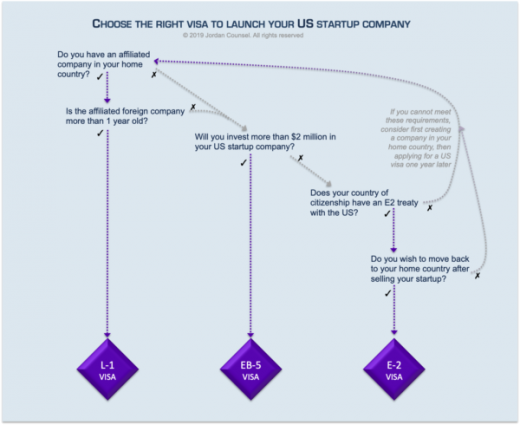How to Overcome New US Immigration Restrictions To Launch Your Startup Company
Effective November 21, 2019, new rules will make it harder for foreign entrepreneurs to obtain an EB5 Immigrant Investor Visa to launch a startup company in the US. The EB5 visa enables foreign entrepreneurs to get a US green card in exchange for their sizable investment in a commercial enterprise (e.g., a new startup company) in America. However, under the new rules the minimum investment required for an EB5 visa will increase by 80%, as follows:
- For commercial enterprises located in areas that are rural or have high unemployment, the previous required minimum investment was $ 500,000; the new minimum investment will be $ 900,000.
- For standard commercial enterprises (i.e., those not located in rural or high unemployment areas), the EB5 visa’s required minimum investment will increase from $ 1 million to $ 1.8 million.
While this high investment threshold renders the EB5 visa unattainable for many foreign entrepreneurs, two other visa categories with lower investment requirements can be used to launch US startup companies.

Image source: Jordan Counsel
E2 VISAS
The E2 visa allows entrepreneurs from certain countries to move to America to direct and develop a US company in which they have made a substantial investment. The nationalities that are eligible for an E2 visa occasionally change. For example, Israelis and New Zealanders just became eligible for the E2 visa in May and June (respectively) of this year.
Compared to the EB5 visa’s new requirements, the investment amount needed for an E2 visa is quite low. For example, some entrepreneurs obtain an E2 visa while ‘only’ investing $ 100,000. E2 visa rules do not specify a certain amount of money that must be invested; the investment must simply be “substantial.” To evaluate whether an E2 investment is sufficiently substantial, consular officials use various metrics, such as proportionality and marginality. Simply put, the E2 visa applicant must demonstrate (typically in a detailed business plan) that the company is sufficiently capitalized and will soon generate enough revenue to cover salaries of a few employees–including the visa holder–and still be profitable.
The E2 visa does not pave the way to a green card. However, because it is possible to obtain unlimited renewals of an E2 visa (if the underlying business is still operating profitably), long-term indefinite stays in the US are possible. If the company is sold, though, the E2 visa will not be renewed.
L1 VISAS
The L1 visa is used for intracompany transfers of foreign employees to America. Such a transfer can be used to launch a US subsidiary, branch office or other type of company affiliated with a foreign entrepreneur’s overseas company.
Typically the investment amount needed for an L1 visa is less than what would be needed for an E2 visa application. This makes sense, since only a portion of the business’ worldwide budget would be allocated to the US company. Nevertheless, the business plan that accompanies the L1 visa application should demonstrate that the US company has adequate facilities and will quickly become commercially successful.
Two main parties play a role in the L1 visa application process: the US company (the “Applicant”) and the person who will receive the visa to work for the Applicant (the “Beneficiary”). The L1 visa envisions that the overseas company will have sufficient staff to continue operations while the Beneficiary is working in the US. For this reason ‘solopreneurs’ usually are not eligible for the L1 visa. If the Beneficiary is the CEO of the overseas company, the visa application should include evidence (e.g., a letter from human resources or a board member) of the Applicant’s intent to have the Beneficiary return to the overseas company after launching the US company.
Despite the assumption that the L1 visa Beneficiary will eventually return to work for the overseas company, for some entrepreneurs an L1 visa can expedite the pathway to a green card if:
- They have worked for the company (overseas or in the US) in an executive or managerial capacity for at least one year, and
- The Applicant has been in business for at least one year.
If those requirements are fulfilled before the L1 visa application is submitted, Beneficiaries may become eligible for the US green card as soon as they arrive in the US. In this context, the L1 visa can (vis-à-vis the EB5 visa) sometimes offer foreign entrepreneurs a faster and less costly pathway to a green card.
In summary, if entering the US market is a strategic imperative for your business, don’t get discouraged by the new restrictions of the EB5 visa. Carefully consider the conditions and benefits of other visa options and start planning accordingly.
Business & Finance Articles on Business 2 Community
(23)


